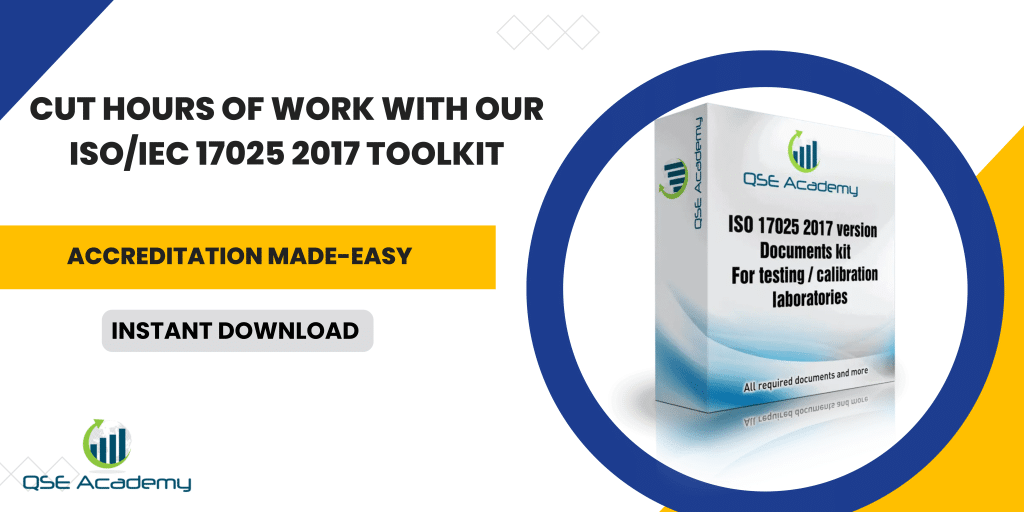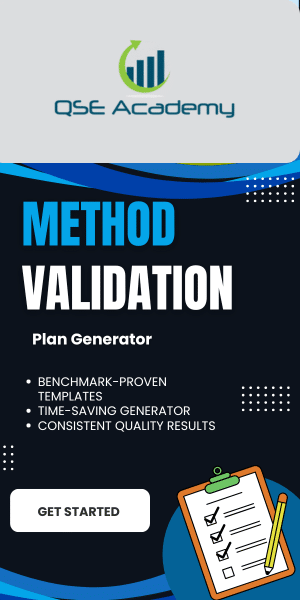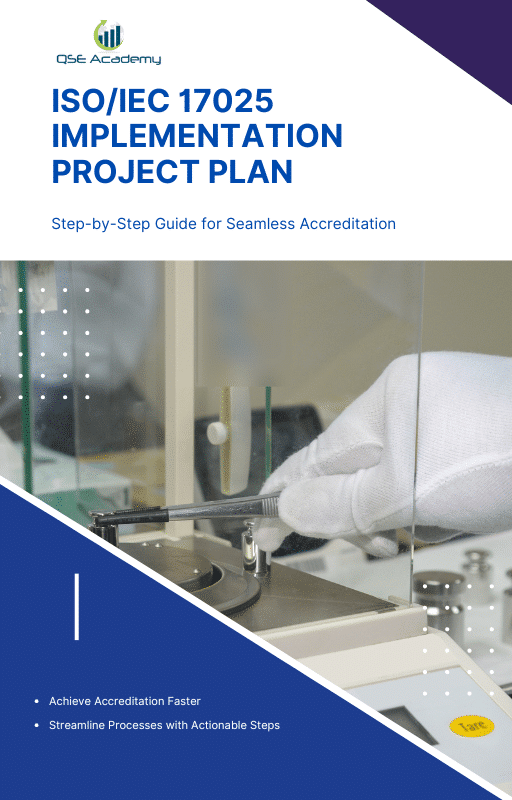Top ISO/IEC 17025 Audit Non‑Conformities
Last Updated on October 13, 2025 by Melissa Lazaro
Why Every Lab Faces Non-Conformities (and Why That’s Okay)
If you’ve ever walked out of an ISO/IEC 17025 audit thinking, “We did everything right — how did we still get findings?” — trust me, you’re not alone.
In my years supporting testing and calibration labs through accreditation, I’ve yet to see a single audit with zero non-conformities. And that’s not a bad thing.
Non-conformities aren’t failures — they’re feedback. They tell you where your system needs a tune-up, not a teardown.
The key is knowing what usually goes wrong and why. Because once you understand the patterns, you can fix most of them before the auditor ever walks in.
In this article, I’ll walk you through:
-
The most common ISO/IEC 17025 audit findings (by clause).
-
The root causes behind them.
-
Practical fixes you can apply right away.
-
And a few real-world examples from labs that learned the hard way — so you don’t have to.
By the end, you’ll see non-conformities for what they really are: early warning lights that help you build a stronger, more confident lab.
What Counts as a Non-Conformity in ISO/IEC 17025?
Here’s the thing most labs misunderstand: a non-conformity isn’t the end of the world — it’s simply evidence that something in your system didn’t meet a requirement. It could be a missing record, an expired calibration, or a process not followed as documented. That’s it.
Assessors aren’t there to shame you. Their job is to verify compliance and competence — and when something doesn’t align with ISO/IEC 17025, it gets recorded as a finding. What matters most is how you respond.
Major vs. Minor Non-Conformities
Major Non-Conformity
A significant issue that directly affects the reliability of your results or your management system.
Example: Using equipment that’s overdue for calibration or has no traceable certificate.
Minor Non-Conformity
A smaller issue that doesn’t affect validity but still breaches a requirement.
Example: A missing date on a training record or an outdated SOP reference.
Observation or Opportunity for Improvement (OFI)
This isn’t a non-conformity. It’s an assessor’s suggestion — a way to make your system even stronger. Smart labs pay attention to these; they’re often insights drawn from seeing hundreds of other labs.
Pro Tip: Link Everything to the Clause
When you document findings, always tie them to the exact ISO/IEC 17025 clause.
It shows you understand the requirement, and it helps you track patterns over time.
If you notice multiple findings under Clause 6.2 (Personnel Competence), that’s your cue to focus your next internal audit there.
Real-World Perspective
I once supported a small calibration lab that received 12 findings in their first audit. They were devastated — until we realized ten were minor and all fixable within two weeks.
A year later, that same lab passed with flying colors because they learned to treat findings as data, not disaster.
Top Non-Conformities in ISO/IEC 17025 Audits (by Clause Category)
Ask any experienced assessor where labs struggle most, and you’ll hear the same three words: resources, processes, and management.
That’s because most ISO/IEC 17025 findings trace back to these areas — not because labs don’t care, but because these are the parts that need constant maintenance.
Let’s break down the most common non-conformities by clause, why they happen, and how to fix them before they show up in your next audit.
Clause 6 – Resource Requirements
This section covers people, equipment, and environmental conditions — the foundation of reliable results.
Most common findings:
-
Missing or outdated training and competence records.
-
Equipment used past its calibration due date or without a traceable certificate.
-
Environmental logs (temperature, humidity) incomplete or missing.
Example:
A calibration lab was using a reference thermometer that hadn’t been verified for almost a year. Nobody noticed because the spreadsheet tracking due dates wasn’t updated. It earned them a major non-conformity.
Fix:
-
Maintain a calibration tracking log with automated reminders.
-
Schedule quarterly competence reviews — short, simple checks that confirm each technician is still qualified for their assigned tests.
-
Keep environmental records visible and signed off daily.
Pro Tip: Don’t just train staff once — re-assess their competence whenever equipment, methods, or software change.
Clause 7 – Process Requirements
This is where most technical issues pop up. It’s the heart of your laboratory operations.
Typical findings:
-
Method validation not documented for modified or in-house methods.
-
Measurement traceability gaps — missing links to SI units or unaccredited calibration sources.
-
Reporting errors such as wrong units, outdated uncertainty values, or missing authorization signatures.
Example:
One testing lab failed to update its uncertainty calculations after upgrading to new equipment. Their reports were still using old data — and the assessor caught it in the first hour.
Fix:
-
Re-validate methods whenever instruments, reagents, or conditions change.
-
Keep a traceability matrix showing how each measurement links back to national standards.
-
Review your test report templates annually to ensure they reflect current practices.
Pro Tip: Make uncertainty reviews part of your management-review inputs — not an afterthought before audits.
Clause 8 – Management System Requirements
This area reveals how well your lab’s system holds together day to day.
Frequent findings:
-
Internal audits done late, incomplete, or too generic.
-
Management reviews missing key inputs (risk, improvement opportunities, client feedback).
-
Document-control lapses — old versions still in use, or uncontrolled copies floating around.
Example:
A lab had two versions of the same SOP — one in print and one on their server. Staff followed different versions, and the assessor spotted inconsistencies in the data. It turned into a system-wide corrective action.
Fix:
-
Conduct internal audits with process-specific checklists instead of generic templates.
-
Centralize all procedures under controlled access.
-
Schedule your management review at least once a year — and always after completing internal audits.
Pro Tip: Keep one person responsible for document control, but make everyone accountable for using the latest version.
Root Causes Behind Most Non-Conformities
Here’s the truth: non-conformities don’t appear out of nowhere. They’re symptoms of something deeper — a weak link in your system that’s been quietly building over time.
And in my experience, once you learn to spot the root causes, you’ll find that most findings are 100 % preventable.
Let’s unpack the real reasons labs keep running into the same audit issues year after year.
1. Lack of Awareness or Training
This one tops the list. A technician forgets to sign a log. A supervisor overlooks a calibration date. It’s not negligence — it’s a training gap.
Why it happens: People often get trained once, then expected to remember forever.
How to fix it:
-
Schedule short, recurring refresher sessions (15–30 minutes works).
-
Use real examples from your last audit instead of generic slides — relevance sticks.
-
Reinforce accountability by having staff sign off on training completion and competence checks.
Pro Tip: The best labs don’t train people “for ISO” — they train them to understand why the requirement exists.
2. Weak Follow-Through on Corrective Actions
Many labs treat corrective actions like boxes to tick. They fix the immediate issue but never confirm the solution worked.
Assessors can tell — especially when the same non-conformity reappears the next year.
How to fix it:
-
Build in a verification step 30 days after closing any corrective action.
-
Ask, “Has this change actually prevented recurrence?”
-
If not, revisit your root-cause analysis — you may have stopped too soon.
3. Overreliance on Templates
Templates are great starting points, but ISO/IEC 17025 expects your system to reflect your operations. I’ve seen labs download a free procedure online, change the logo, and call it done.
During an audit, that backfires fast.
Fix: Customize every procedure to match your workflow, terminology, and equipment.
If a clause doesn’t apply, explain why — don’t delete it. Assessors respect transparency more than copy-paste compliance.
4. Staff Turnover Without Knowledge Transfer
When key people leave, so does their undocumented know-how. Suddenly no one remembers why a method was validated a certain way.
That’s a silent risk — and a frequent audit pain point.
Fix:
-
Keep process maps and validation summaries accessible.
-
Cross-train at least one backup for each technical and quality role.
-
Make “handover documentation” part of your offboarding checklist.
Pro Tip: During audits, assessors often spot turnover gaps simply by asking, “Who’s responsible for this now?”
5. Compliance Mindset Instead of Improvement Mindset
Some labs only think about ISO/IEC 17025 when the audit calendar rolls around. They run the system to satisfy assessors, not to strengthen performance.
But compliance without ownership breeds mistakes.
Fix:
-
Shift the mindset from “We have to” to “We get to improve.”
-
Use internal audits to identify efficiency wins, not just gaps.
-
Celebrate improvements between audits — it keeps engagement alive.
Bottom line:
Non-conformities aren’t caused by the standard. They’re caused by weak habits, unclear responsibilities, or outdated systems.
Once you start treating root causes instead of symptoms, you’ll notice fewer findings — and a more confident team.
How to Prevent Repeat Non-Conformities
If you’ve ever had the same finding show up in multiple audits, you know how frustrating it feels. It’s like déjà vu — the issue never truly disappears, just rephrases itself.
The good news? Preventing repeat non-conformities isn’t about working harder. It’s about working smarter — building habits and systems that catch weak spots before the assessor does.
Here’s how top-performing labs do it.
1. Make Audit Findings Part of Your Management Review
Your management review isn’t just a compliance meeting — it’s your strategic tool for improvement.
Every non-conformity and corrective action should show up there.
Ask:
-
Did our last audit findings resurface?
-
Which processes show recurring issues?
-
What trends do we see over time?
Pro Tip: Plot findings by clause in a simple dashboard. When you see Clause 6.2 (Personnel Competence) pop up repeatedly, that’s a red flag calling for action, not paperwork.
2. Conduct Mini-Audits on High-Risk Areas
Don’t wait for the annual internal audit to find issues. Run short, focused “spot audits” on critical processes every few months.
Example:
One calibration lab started auditing its equipment logs monthly — just 20 minutes per check. Within a year, they eliminated overdue calibrations entirely.
Fix: Schedule mini-audits around areas that affect data integrity — calibration, traceability, and reporting. These bite-sized reviews prevent small errors from growing into full-blown non-conformities.
3. Automate Reminders for Time-Sensitive Tasks
Most repeat findings happen because something expired — a calibration date, a record review, or a training certificate.
Manual tracking systems fail because people get busy.
Solution:
-
Use digital trackers for calibration due dates and document revisions.
-
Set automated email reminders for upcoming expirations.
-
Review reminders during weekly operations meetings.
Pro Tip: A simple Google Sheet with conditional formatting (turning cells red for overdue dates) works wonders for smaller labs.
4. Train With Real Audit Examples
Generic ISO training doesn’t stick. Real scenarios do.
If your last audit uncovered a missing uncertainty calculation, walk your team through how it happened, why it mattered, and how you fixed it.
People remember lessons tied to real stories — especially their own.
That’s how awareness turns into prevention.
5. Assign “Clause Owners” for Accountability
Here’s one of the smartest moves I’ve seen: give each key staff member ownership over a clause or process.
For instance, one technician owns Clause 6.4 (Equipment), another owns Clause 7.2 (Method Validation), and so on.
Their job? Keep their section current, track updates, and flag risks early.
It spreads accountability and builds internal expertise over time.
Example:
A testing lab that adopted this approach cut repeat findings by 70% in a year — simply because everyone had eyes on their piece of the system.
Common Pitfall: Treating Preventive Action as Optional
ISO/IEC 17025 doesn’t explicitly require “preventive actions” anymore — but mature labs still use them.
Why wait for something to break before fixing it?
Keep a running list of “near misses” — things that almost went wrong — and address them proactively. Auditors love seeing that level of control.
Case Snapshot – What Happens When You Don’t Act Fast
Here’s a story I share often with lab managers — because it perfectly illustrates why closing findings quickly isn’t just about compliance. It’s about credibility.
A mid-sized testing lab I worked with had been performing well for years. During one audit, they received a few minor non-conformities — outdated training records, incomplete calibration logs, and a missing reference update.
Nothing major. They assured the assessor everything would be fixed “within a few weeks.”
But weeks turned into months.
When their surveillance audit rolled around, two of the same issues appeared again — this time labeled “repeat findings.”
That’s when the real trouble started.
Their accreditation body viewed it as a systemic weakness, not a documentation slip. The lab was asked to submit additional evidence, reschedule verification visits, and, for a short time, had part of its scope suspended.
It wasn’t the findings that hurt them — it was the lack of timely action.
The Takeaway
Non-conformities don’t damage your accreditation; inactivity does.
Every finding comes with an opportunity and a timeline. Miss that window, and your corrective action turns into a credibility question.
Pro Tip: Treat findings like deadlines, not to-do lists.
Give every one a responsible owner, a due date, and a verification step.
What the Lab Did Next
To recover, the lab rebuilt its system around accountability:
-
They created a corrective-action tracker visible to everyone.
-
Each finding was assigned to a process owner with weekly status checks.
-
Their management review now opens with “Findings Update” as the first agenda item.
The result?
Their next audit came back with zero repeat findings.
The assessor even noted their improvement as a positive observation.
Lesson Learned
Delaying a fix tells auditors your system reacts — it doesn’t manage.
But when you take swift, structured action, you send a stronger message: We know what went wrong, we owned it, and we made it better.
That’s the kind of maturity accreditation bodies remember.
FAQs – Non-Conformities in ISO/IEC 17025 Audits
Over time, I’ve noticed that the same questions come up from lab managers and quality officers after every audit. So let’s address them clearly — the way an assessor or consultant would explain them behind closed doors.
Q1. What’s the difference between a non-conformity and an observation?
A non-conformity is a direct breach of an ISO/IEC 17025 requirement — something that didn’t meet the standard or your own procedure.
An observation (or “opportunity for improvement”) isn’t a failure — it’s the assessor’s professional advice. It’s their way of saying, “You’re compliant, but here’s how you could do this better.”
Example:
-
Non-conformity: Missing calibration certificate for a critical instrument.
-
Observation: Suggestion to add temperature logs next to your calibration records for better traceability.
Smart labs treat observations seriously — they often predict where future findings might arise.
Q2. How long do we have to close findings after an audit?
Most accreditation bodies give between 30 and 90 days to submit corrective actions and objective evidence.
But here’s the thing — you shouldn’t wait that long.
The best labs start working on findings the same week the audit ends.
Pro Tip: Draft your root-cause analysis and action plan before the official report even arrives. You’ll save valuable time and show initiative.
Q3. Can we challenge a non-conformity if we disagree with it?
Yes, absolutely. If you believe a finding was issued in error or misinterprets your process, you can request clarification or submit additional evidence.
Accreditation bodies welcome professional dialogue — just make sure your response is factual, not defensive.
How to approach it:
“Based on our records (attached), we believe this activity complies with Clause 7.6. Please review the supporting evidence for consideration.”
That’s calm, clear, and constructive — assessors respect that tone.
Q4. Do small labs get more leniency?
No — the requirements are the same regardless of size.
However, assessors do consider context and scale.
For example, a two-person lab might have a simpler structure, but it still needs the same traceability, impartiality, and control over methods as a large organization.
Tip: Smaller labs actually have an advantage — fewer layers mean faster fixes and stronger ownership.
Q5. What’s the best way to track and manage non-conformities?
Use a simple, transparent Corrective Action Register that captures:
-
The finding (and clause number)
-
The root cause
-
The corrective action
-
The responsible person
-
The completion and verification date
It doesn’t have to be fancy — a spreadsheet works fine if it’s kept current.
What matters is visibility. When everyone can see the status, accountability naturally follows.
Strong Systems Don’t Fear Findings
Here’s the honest truth: every lab, no matter how skilled or well-managed, will face non-conformities at some point. What separates high-performing labs from the rest isn’t the absence of findings — it’s how they respond to them.
The strongest labs don’t treat audits like judgment day. They treat them like a mirror — a reflection of where the system stands and where it can improve.
What We’ve Learned
Let’s recap the big takeaways from years of watching labs turn audit stress into audit success:
-
Understand the difference between major, minor, and observational findings — and respond proportionally.
-
Know your weak spots: training, calibration, document control, and management reviews are the most common culprits.
-
Dig into root causes, not quick fixes. Problems repeat when causes stay hidden.
-
Don’t delay corrective actions — fast, clear responses show auditors you’re in control.
-
Track progress using a simple system that everyone can see and own.
Each of these steps shifts your lab from reactive to proactive — and that’s the ultimate sign of competence.
A Mindset Shift That Changes Everything
I’ve seen labs transform once they stopped fearing findings.
One calibration lab told me, “We used to dread audits. Now we use them as free performance reviews.”
That’s the mindset ISO/IEC 17025 was built for — continual improvement through evidence, not perfection through pressure.
When your team understands that every non-conformity is a lesson, your system naturally becomes stronger, leaner, and more confident.
Your Next Step
If you’re preparing for your next ISO/IEC 17025 audit — or recovering from one — start by organizing what you’ve just learned.
Download QSE Academy’s “ISO/IEC 17025 Non-Conformity Tracker & Root Cause Template.”
It’s the same structured tool we use when helping labs respond to findings efficiently — without overwhelm.
Or, if you’d rather skip the guesswork, book a consultation with our ISO 17025 experts. We’ll review your audit report, identify root causes, and build a corrective-action plan that actually closes the loop.
Because at the end of the day, audit findings aren’t the enemy.
They’re the roadmap to a stronger, more credible, and more confident laboratory system.
I hold a Master’s degree in Quality Management, and I’ve built my career specializing in the ISO/IEC 17000 series standards, including ISO/IEC 17025, ISO 15189, ISO/IEC 17020, and ISO/IEC 17065. My background includes hands-on experience in accreditation preparation, documentation development, and internal auditing for laboratories and certification bodies. I’ve worked closely with teams in testing, calibration, inspection, and medical laboratories, helping them achieve and maintain compliance with international accreditation requirements. I’ve also received professional training in internal audits for ISO/IEC 17025 and ISO 15189, with practical involvement in managing nonconformities, improving quality systems, and aligning operations with standard requirements. At QSE Academy, I contribute technical content that turns complex accreditation standards into practical, step-by-step guidance for labs and assessors around the world. I’m passionate about supporting quality-driven organizations and making the path to accreditation clear, structured, and achievable.












